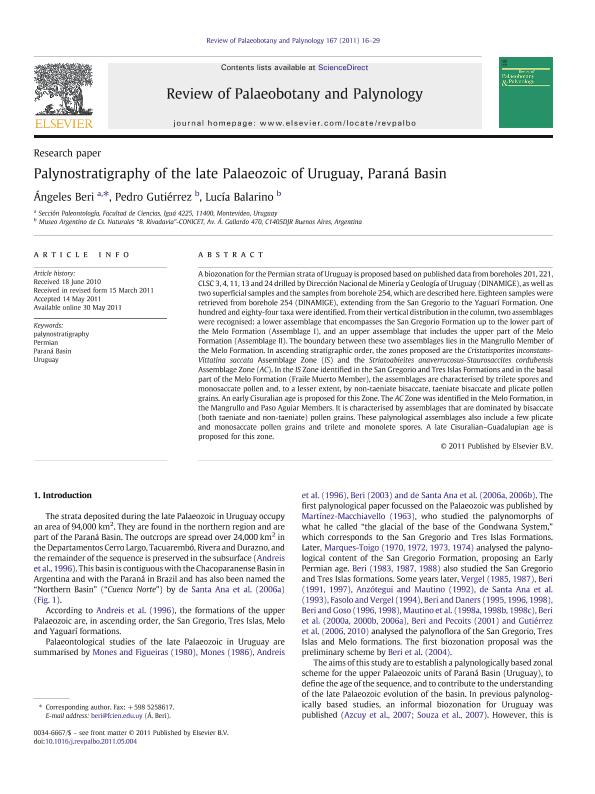Mostrar el registro sencillo del ítem
dc.contributor.author
Beri Castagnini, Ángeles

dc.contributor.author
Gutierrez, Pedro Raul

dc.contributor.author
Balarino, María Lucía

dc.date.available
2019-01-30T16:58:25Z
dc.date.issued
2011-09
dc.identifier.citation
Beri Castagnini, Ángeles; Gutierrez, Pedro Raul; Balarino, María Lucía; Palynostratigraphy of the late palaeozoic of Uruguay, paraná basin; Elsevier Science; Review of Palaeobotany and Palynology; 167; 1-2; 9-2011; 16-29
dc.identifier.issn
0034-6667
dc.identifier.uri
http://hdl.handle.net/11336/68992
dc.description.abstract
A biozonation for the Permian strata of Uruguay is proposed based on published data from boreholes 201, 221, CLSC 3, 4, 11, 13 and 24 drilled by Dirección Nacional de Minería y Geología of Uruguay (DINAMIGE), as well as two superficial samples and the samples from borehole 254, which are described here. Eighteen samples were retrieved from borehole 254 (DINAMIGE), extending from the San Gregorio to the Yaguarí Formation. One hundred and eighty-four taxa were identified. From their vertical distribution in the column, two assemblages were recognised: a lower assemblage that encompasses the San Gregorio Formation up to the lower part of the Melo Formation (Assemblage I), and an upper assemblage that includes the upper part of the Melo Formation (Assemblage II). The boundary between these two assemblages lies in the Mangrullo Member of the Melo Formation. In ascending stratigraphic order, the zones proposed are the Cristatisporites inconstans-Vittatina saccata Assemblage Zone (IS) and the Striatoabieites anaverrucosus-Staurosaccites cordubensis Assemblage Zone (AC). In the IS Zone identified in the San Gregorio and Tres Islas Formations and in the basal part of the Melo Formation (Fraile Muerto Member), the assemblages are characterised by trilete spores and monosaccate pollen and, to a lesser extent, by non-taeniate bisaccate, taeniate bisaccate and plicate pollen grains. An early Cisuralian age is proposed for this Zone. The AC Zone was identified in the Melo Formation, in the Mangrullo and Paso Aguiar Members. It is characterised by assemblages that are dominated by bisaccate (both taeniate and non-taeniate) pollen grains. These palynological assemblages also include a few plicate and monosaccate pollen grains and trilete and monolete spores. A late Cisuralian-Guadalupian age is proposed for this zone.
dc.format
application/pdf
dc.language.iso
eng
dc.publisher
Elsevier Science

dc.rights
info:eu-repo/semantics/openAccess
dc.rights.uri
https://creativecommons.org/licenses/by-nc-sa/2.5/ar/
dc.subject
Palynostratigraphy
dc.subject
ParanÁ Basin
dc.subject
Permian
dc.subject
Uruguay
dc.subject.classification
Meteorología y Ciencias Atmosféricas

dc.subject.classification
Ciencias de la Tierra y relacionadas con el Medio Ambiente

dc.subject.classification
CIENCIAS NATURALES Y EXACTAS

dc.title
Palynostratigraphy of the late palaeozoic of Uruguay, paraná basin
dc.type
info:eu-repo/semantics/article
dc.type
info:ar-repo/semantics/artículo
dc.type
info:eu-repo/semantics/publishedVersion
dc.date.updated
2019-01-30T13:55:29Z
dc.journal.volume
167
dc.journal.number
1-2
dc.journal.pagination
16-29
dc.journal.pais
Países Bajos

dc.journal.ciudad
Amsterdam
dc.description.fil
Fil: Beri Castagnini, Ángeles. Universidad de la República. Facultad de Ciencias; Uruguay
dc.description.fil
Fil: Gutierrez, Pedro Raul. Consejo Nacional de Investigaciones Científicas y Técnicas. Oficina de Coordinación Administrativa Parque Centenario. Museo Argentino de Ciencias Naturales “Bernardino Rivadavia”; Argentina
dc.description.fil
Fil: Balarino, María Lucía. Consejo Nacional de Investigaciones Científicas y Técnicas. Oficina de Coordinación Administrativa Parque Centenario. Museo Argentino de Ciencias Naturales “Bernardino Rivadavia”; Argentina
dc.journal.title
Review of Palaeobotany and Palynology

dc.relation.alternativeid
info:eu-repo/semantics/altIdentifier/url/http://www.sciencedirect.com/science/article/pii/S0034666711000686
dc.relation.alternativeid
info:eu-repo/semantics/altIdentifier/doi/https://doi.org/10.1016/j.revpalbo.2011.05.004
Archivos asociados
